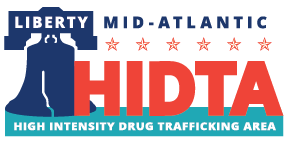Regional Threat Summary
The twelve-county Liberty Mid Atlantic HIDTA (LMA HIDTA) is contained within the seventh largest metropolitan area in the United States, comprising 6 million people. Approximately 100 million additional people live within a one day drive of the LMA HIDTA. The region’s ethnic diversity and varying degrees of economic prosperity contribute significantly to the amount of drug trafficking and distribution, illicit financial activity, and violent crime that occurs in each county. The LMA HIDTA sits within one of the most dangerous and violent regions in the nation, as Philadelphia, Camden, and Wilmington (DE) remain near the top of the rankings of the most violent cities in the country.
Fentanyl and fentanyl-related substances, counterfeit pills, cocaine, and methamphetamine are the primary drug threats to the LMA HIDTA. Fentanyl-related overdose deaths continue to climb throughout the LMA HIDTA, along with the presence of counterfeit pills. In response, law enforcement, policy makers, and the public health communities are constantly monitoring, assessing, responding to this dangerous trend. Additionally, the HIDTA Overdose Response Strategy (hyperlink to addressing the issue page) strives to enhance relationships between public health and law enforcement entities to advance overdose-related information collection and sharing practices.
Home to 6 million people, the metropolitan Philadelphia area continues to experience high levels of substance abuse, drug trafficking and drug-related violence in densely populated urban centers such as Philadelphia, Wilmington and Camden, and increasingly these same problems are reported in more affluent suburban and rural sections of the region.
DTOs and money laundering organizations (MLOs) operating in southeastern Pennsylvania, southern New Jersey, and northern Delaware are closely linked to larger domestic and international criminal groups, whom they depend on for drug supply and are obligated to return cash proceeds. Mexican DTOs, linked with transnational criminal organizations such as the Gulf, Sinaloa, La Familia, Los Caballeros Templarios (Knights Templar), and Juarez cartels, or their domestic cells, remain the dominant suppliers of heroin, cocaine, marijuana, and methamphetamine.
Urban areas within the LMA HIDTA consistently rank among the most dangerous and violent regions in the country, due in no small part to the impact of drug trafficking, distribution, and drug-related violent crime. Throughout the LMA HIDTA, territorial violence is rampant within inner-city neighborhoods, extending now more frequently to suburban communities where distribution groups as well as neighborhood-based and nationally-connected street gangs compete for control of profitable drug markets using violence and intimidation tactics.
- Mexican DTOs, in close association with Dominican, Puerto Rican, and African American distribution networks, will continue to dominate illicit drug trafficking and distribution in the LMA HIDTA. Violent crime among DTOs will remain prevalent and a significant threat to public safety in the LMA HIDTA. There exists a marriage between drugs and violence that will likely continue. Further, the low cost of 3D printers will help with the manufacturing and distributing of ghost guns. This will continue to fuel the gun violence epidemic due to their ability to be untraceable.
- With new analogues continuing to surface, and by garnering a growing share of drug overdose fatalities, fentanyl and fentanyl-related substances will remain the region’s top drug threat. The presence of fentanyl in counterfeit prescription pills will continue to exacerbate the issue. A rise in counterfeit pill production both locally (supported by a rise in local pill press seizures) and in Mexico merits acute monitoring as these pills are often found to contain fentanyl and/or fentanyl-related substances and amateur production is causing an inconsistent level of potency for unsuspecting users. Additionally, rising stimulant drug dispensing in/around Philadelphia warrants scrutiny for the potential of increased demand/diversion.
- Cocaine availability will likely increase, as COVID-19 pandemic-related supply chain restrictions continue to loosen. As overdose death detections continue to rise throughout the LMA HIDTA, it will be vital to monitor cocaine demand and discern indicators hinting at potential cocaine/opioid interplay regarding user habits. Distributors and retail-level dealers will likely continue to add fentanyl to cocaine and other stimulants presenting implications for public health and law enforcement.
- New Jersey’s legalization of recreational marijuana may increase certain harms. The considerable growth of medical marijuana dispensary operations in Pennsylvania and Delaware may create increased supply and diversion opportunities. Efforts will persist toward legalizing recreational marijuana in Delaware and Pennsylvania, following the recent legislation in New Jersey.
- Methamphetamine usage will continue to increase in non-traditional urban centers such as Philadelphia and among the suburban Greater Philadelphia Area. Availability will likely continue to rise via increasing production and investment by Mexican cartels, fueling ongoing usage as demonstrated by CBP seizures at the SW border, several years of increasing postmortem toxicology detections throughout the LMA HIDTA and supporting reporting of communities flooded with product.
- Synthetic substances such as LSD, MDMA, and Molly will remain attractive drugs of abuse, particularly among younger users. Synthetic drug influence will take root through ease of online procurement and perceived legality for direct use. The rapidly changing synthetic stimulant market will likely pose significant problems for users, public health, and law enforcement officials.
- Digital tactics, such as virtual currency and social media, will likely prevail as a popular means for drug trafficking and money laundering as technologies continue to evolve. Technological advancements will likely pose challenges to law enforcement due to learning curves and rapid change.



